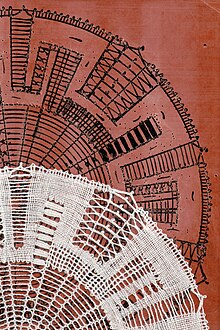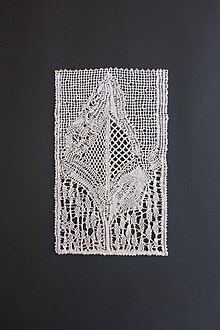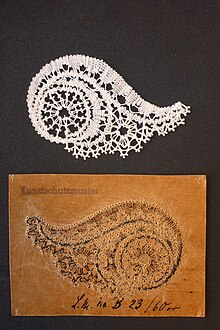Leni Matthaei
Helene Anna Dorothea Matthaei , called Leni (* 2. June 1873 in Stade ; † 24. January 1981 in Reutlingen ), was a German artist who in the time of the transition from historicism to modernism lace designed and clapper art gave new impetus.
life and work
Leni Matthaei was the second child of the married couple Robert Matthaei and Henriette Klopp. She attended the secondary school for girls in Clausthal / Harz . In 1884 the father died. The mother moved with the four children to Hanover , where Leni Matthaei attended the secondary school for girls. She stayed with her aunt in Leer ( East Friesland ) for a year and spent nine months in London in exchange with the son of an English family.
In 1893 she attended arts and crafts classes for women and girls in Hanover. From 1894 to 1896 she stayed in Costa Rica with a school friend and then continued her arts and crafts classes. She took private lessons and designed wallpaper, damask fabrics, oilcloths and machine tulle. She designed the first sample boards for bobbin lace in 1905. It was published in 1906 in the German Art and Decoration magazine .
Leni Matthaei moved to Paris in 1907 for four months of private study with Madame Marguerite Charles, director of the Ecole des Dentelles et Broderie . In 1914 she was accepted into the German Werkbund . After serving in the National Women's Service , she began to work with various top schools. She continued her education in life drawing and composition.
In 1943, in a bombing raid on Hanover, she lost her apartment, her workshop, study materials and lace lessons .
Leni Matthaei moved to Reutlingen and died there in 1981 at the age of 107 as the oldest resident of Baden-Württemberg at the time.
Working method
Leni Matthaei first made sketches with wax pencils or as watercolor and then developed modern designs for handcrafted bobbin lace. It gave new impulses to the art of lace. In the 1920s, avant-garde works emerged in the geometric-abstract style of Art Deco . She commissioned lace makers to carry out her designs. She was creative well into old age.
Exhibitions
- 1913 World Exhibition in Ghent
- 1914 Applied arts exhibition of the Deutscher Werkbund in Cologne
- 1918 Easter sample fair in Leipzig
- 1929 World Exhibition in Barcelona
Prices
- 1913 gold and silver medal at the world exhibition in Ghent
- 1929 gold medal at the world exhibition in Barcelona
- 1963 Cross of Merit on Ribbon of the Federal Republic of Germany
- 1965 State Prize of the State of Baden-Württemberg
- 1967 State Prize from the Bavarian State Government
- 1972 State Prize of the State of Baden-Württemberg
Works
- German bobbin lace . Otto Bayer publishing house, Leipzig 1925.
- Leni Matthaei - new German top art . Karlsruhe 1962.
literature
- Leni Matthaei. 20th century lace . Catalog for the exhibition in the Heimatmuseum Reutlingen on the 125th birthday of Leni Matthaei April 26th - June 21st 1998, edited by Martina Schröder, ISBN 3-927228-83-4 .
- Leni Matthaei. Lace in the collection of the German Lace Association, ISBN 978-3-934210-51-6
- Inge Mühlensiepen: Leni Matthaei, a life for the bobbin lace . Hanover 1980, ISBN 3-7944-0110-7 .
Web links
- Work Abstract Landscape by Leni Matthaei in MoMA
Individual evidence
- ↑ Heimatmuseum Reutlingen (ed.): Leni Matthaei . ISBN 3-927228-83-4 .
- ↑ Leni Matthaei lace in the collection of the German Lace Association. Retrieved December 8, 2018 .
| personal data | |
|---|---|
| SURNAME | Matthaei, Leni |
| ALTERNATIVE NAMES | Matthaei, Helene Anna Dorothea (full name) |
| BRIEF DESCRIPTION | German artist |
| DATE OF BIRTH | June 2, 1873 |
| PLACE OF BIRTH | Stade |
| DATE OF DEATH | January 24, 1981 |
| Place of death | Reutlingen |









